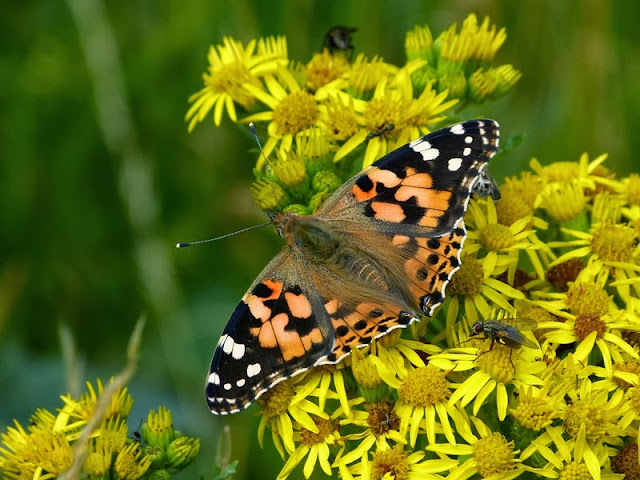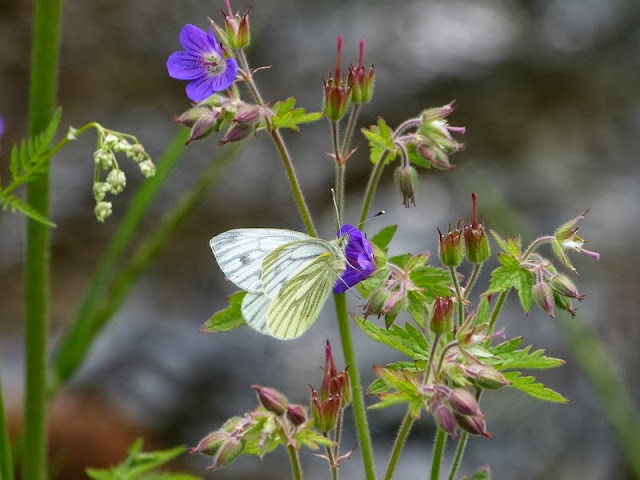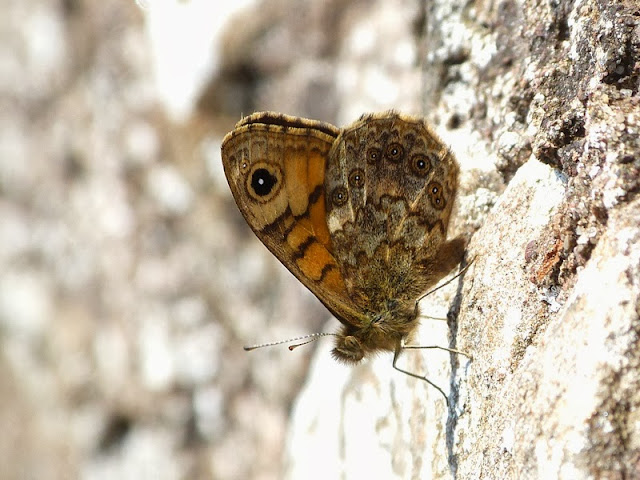The weather in 2013 was a big
improvement on the previous two years. Although the winter wasn’t particularly hard,
it dragged on for a long time, and spring didn’t arrive until half way through
April. This, and I think last year’s very poor weather, had an impact on the
number of butterflies early in the year. Other than a couple of sightings in
March, the first records of butterflies didn’t come in until 26th April!
However, from mid April until
the end of August, the weather was reasonably warm, dry and sunny. It was never
particularly hot, so there was a continuous source of food plants and the number of butterflies really picked up during July and August. The weather in September and
October was rather disappointing, so we didn’t get the influx of butterflies
migrating north, that we were hoping for. The first frosts arrived in early
November, putting an end to the butterfly season.
Peacock, Aglais io
The first record I received this
year was a Peacock, seen on North Berwick Law on the 1st March. There
were a few seen throughout the spring, but the number seen dropped at the end
of May. In August, though, there was a sudden explosion of Peacocks when the
next generation appeared. Numbers through August were the highest I can remember
seeing.
 |
| Peacock |
Small Tortoiseshell, Aglais urticae
The first record this year of a
Small Tortoiseshell in East Lothian was on 2nd March. After that
they appeared regularly through to May. Like the Peacock their numbers picked
up considerably with the new generation in July and August.
 |
| Small Tortoiseshell |
Painted Lady, Vanessa cardui
One Painted Lady was recorded on
25th April, but it wasn’t until the end of June that more were seen having worked their way northwards through Europe. They weren’t seen up
here in great numbers this year, though.
 |
| Painted Lady |
Green-veined White, Pieris napi
The butterfly season kicked off
properly with the first record of a Green-veined White on 26th April. Numbers were a little low, but they were seen regularly up until the
middle of June. In July the second generation appeared with a vengeance. It
seems that the weather conditions must have been perfect for them this year
with numbers peaking around the middle of August.
 |
| Green-veined White |
Small White, Pieris rapae
The first record of a Small
White this year was on 29th April, which is more than a month later
than last year and two months later than 2011. This just shows how their
emergence is related to the weather. Like the Green-veined Whites, their
numbers were low for the spring generation, but when the second generation
started to appear at the beginning of August they were seen in far greater
numbers than they have been for many years.
 |
| Small White |
Comma, Polygonia c-album
The Comma is a butterfly that
isn’t seen in great numbers here. It was first recorded in East Lothian in 2004 and is now
seen all over the county, but rarely more than one at a time. The first one
recorded here this year was on 30th April and a few records kept
trickling in until the end of October. I find it odd that we never see it in
greater numbers like the Small Tortoiseshell or Peacock with which it shares a
similar life cycle and food plant.
 |
| Comma |
Orange Tip, Anthocharis cardamines
The first Orange Tip seen this
year was on 7th May. Their numbers were lower than average, but
considering the rain and flooding we had last year this isn’t surprising. They
don’t have a second summer generation like the other whites, but hopefully they
should do well next year. Strangely, I didn’t see very many eggs or
caterpillars, which are normally fairly easy to spot.
 |
| Orange Tip |
Large White, Pieris brassicae
The first Large White was seen
on 7th May. Generally we don’t see Large Whites in great numbers
here, however this year, as with the other species from August onwards we had
unusually high numbers of Large Whites. It wasn’t unusual to see more than 40
on a buddleia bush.
 |
| Large White |
Speckled Wood, Pararge aegeria
Speckled Woods are butterflies
that excite me a lot! In 2009 we received our first couple of records of them
in East Lothian. The following year I found a small colony of them and since
then they have increased in numbers year on year. The first record this year
was on 14th May. After that records came in from all over the north
and middle of the county. It seems that they first arrived here on the east
coast having spread up from the Scottish Borders. This year they have worked
their way almost along the entire length of the coast and up the River Tyne
valley. It is amazing to see such a rapid spread of this species and next year
I won’t be surprised if they are seen all over the county.
 |
| Speckled Wood |
Holly Blue, Celastrina argiolus
I only received one record of a Holly
Blue this year on the 21st May. This was sad after they had been
seen in various locations over the previous two years. Hopefully this one
sighting means that they are still clinging on at the long-established colony
in the west of East Lothian.
Red Admiral, Vanessa atalanta
The first Red Admiral we saw
this year was on May 22nd. Thereafter they were seen a few times, but compared
with other butterflies this year, they weren't around in great numbers. I think
the long winter was too much for any of them to survive and we didn't get very
many making their way up from Europe.
Small Copper, Lyceana phlaeas
The weather this year seemed to
suit Small Coppers with the first one being recorded on 30th May and
thereafter higher than normal numbers being spotted. It was interesting to note
that last year the majority of those seen were of the caeruleopunctata
aberration, with a number of blue spots on their hind wings. However, this year
very few aberrations were noted. It is interesting to speculate whether the aberration is a result of the climate, or quality of the caterpillar food plant, or for some other reason.
 |
| Small Copper |
Wall Brown, Lamiommata megera
Like the Speckled Woods, Wall
Browns were first recorded in East Lothian only a few years ago, but they don’t seem
to have spread as quickly. We had a new record of them on North Berwick Law, so
they have spread about half way along the coast in that time. The first record
this year was on 30th May. They seem to occur mostly on the coast,
but in August I saw one six kilometres inland at Woodhall Dean.
 |
| Wall Brown |
Small Heath, Coenonympha pamphilus
The first Small Heath was
recorded on 2nd June. It is a common butterfly along the coast in East Lothian
and it is also found in the Lammermuir Hills. This year they appeared to do as
well as ever.
 |
| Small Heath |
Common Blue, Polyommatus icarus
The common Blue had a fairly
normal year. I think that because they have come from eggs that were laid last year, they seem to be
affected less by this year's good weather. The first Common Blue was seen on 16th June and
they were on the wing until the middle of September.
 |
| Common Blue |
Ringlet, Aphantopus hyperantus
Ringlets have a very short
flight period. They occur in damp grassy areas and normally start to appear in
late June, and this year they turned up right on cue on 21st June. The number
of Ringlets on my transect this year was lower than normal, but that isn't
surprising given that the area was flooded twice last year. At other sites
around East Lothian there were good numbers of Ringlets.
 |
| Ringlet |
Grayling, Hipparchia semele
The Grayling was restricted to a
couple of very small sites in East Lothian, with the odd record of them being
found at other coastal sites in the past, but these seem to be one-offs. The
first Grayling recorded this year was on 25th June at one of the established
sites. Last year a new colony was discovered on a re-landscaped mining spoil
heap close to one of their other colonies. When I visited this colony in mid
July I counted 80 individuals in a short visit, double the number that I saw
last year.
 |
| Grayling |
Meadow Brown, Maniola jurtina
Meadow Browns seemed to do very
well this year. The first record was on 25th June and they were seen in good
numbers up until the end of August. I only saw one on my transect this year,
but again, this isn’t surprising given the flooding we had in that area last
year.
 |
| Meadow Brown |
Dark Green Fritillary, Argynnis aglaja
The Dark Green Fritillary is a
lovely bright butterfly that occurs in many coastal areas and valleys in the
Lammermuir Hills. The first one was seen in East Lothian this year on 30th
June. They never occur in great numbers, and this year proved to be about
average for them.
 |
| Dark Green Fritillary |
Northern Brown Argus, Aricia artaxerxes
I am aware of four colonies of
Northern Brown Argus in East Lothian, but I am sure there are probably more in
the Lammermuir Hills. The colonies are very small, one being based around a
patch of their food plant – the Rockrose, Helianthemum nummularium on a golf
course and another on a small patch of Rockrose in a private garden. I tend to go and specifically look for them
where I know they occur and this year they seemed to be a little later than normal,
but in reasonable numbers.
 |
| Northern Brown Argus |
Small Pearl-bordered Fritillary, Boloria selene
Having visited a reserve in the
Scottish Borders this year to see Small Pear-bordered Fritillaries, I was
delighted to find them at a site just inside East Lothian a couple of weeks
later. There have previously been a few unconfirmed sightings of Small Pearl-bordered
Fritillaries in East Lothian, but this time I saw them long enough and took
some pictures which confirmed their identification. It is funny how seeing a butterfly elsewhere can lead to identifying them in different sites. If I
hadn’t seen those in the Scottish Borders I may have dismissed these as Dark
Green Fritillaries and not looked any closer!
 |
| Small Pearl-bordered Fritillary |
Small Skipper, Thymelicus sylvestris
Another very exciting record
this year was the discovery of a number of Small Skippers at Aberlady Local
Nature Reserve. There had been three isolated sightings of Small Skippers at
two locations in East Lothian the previous two years, but on 12th July I
received an excited phone call from a local volunteer who had found more than
ten of them on a patch of thistles in the reserve. She went on to find more at the reserve and I
then received other records of them at three other locations within three
kilometres of this site. It is great to hear that they are doing well and if we
have good weather next year I am sure we will find them at various other
locations.
 |
| Small Skipper |
Clouded Yellow, Colias croceus
We only very rarely see Clouded
Yellows here. I saw one thirteen years ago and a colleague saw one seven years
ago. This year we received two records. The first was seen in North Berwick on
31st July and the following day we were told of one about 25 kilometres further
along the coast in Musselburgh. I guess it must have been the same individual. In
August and September high numbers arrived in southern England from the continent.
They were seen laying eggs and I was hoping that we would be invaded by the
next generation. Unfortunately the cold weather proved too much for them and
they didn't venture up here!
All together this has been a
fantastic year for butterflies. In total I received sightings of 23 different species,
which I think must be a record for East Lothian. Only ten years ago eight of
those species hadn't been recorded here. It is amazing that so many species
continue to expand their range into East Lothian. We seem to be losing more and
more habitat, and yet the butterflies seem to be better than ever. I wonder
what the next new species will be. I can't wait for next year!